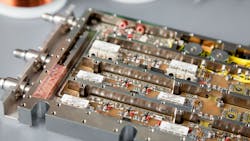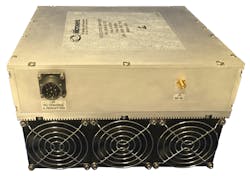Electronic-Warfare Products Enable Military Technology
This file type includes high resolution graphics and schematics when applicable.
Electronic-warfare (EW) capability is a prominent aspect of military technology. To demonstrate its importance, the Pentagon created the Electronic Warfare Programs Council earlier this year. That group was launched to focus on EW strategies and innovations across the entire Department of Defense (DoD). For decades, the U.S. military had demonstrated technological superiority. However, this dominance has diminished as potential adversaries have placed emphasis on EW. Although the U.S. has traditionally seen EW as a supporting technology, other nations consider EW to be more of a core weapon. The Pentagon is hopeful that the launch of this group will help the U.S. military win the EW competition.
EW can be defined as any military action that involves the use of electromagnetic (EM) and directed energy to control the EM spectrum or attack the enemy. Its core purpose is to deny the opponent the advantage of the electromagnetic spectrum. EW can be applied from air, sea, land, and space. Its three major subdivisions are electronic attack (EA), electronic protection (EP), and electronic support (ES). For those who wish to learn more about EW, the Electronic Warfare and Radar Systems Engineering Handbook is a comprehensive handbook that is designed to aid EW and radar systems engineers.
Advanced EW systems are provided by defense contractors, such as Raytheon, Lockheed Martin, and BAE Systems, to name a few. Raytheon, for example, provides an array of EW products including jammers and decoys. The company was awarded the Next-Generation Jammer (NGJ) program in 2013. That program will integrate advanced electronic attack capability into the EA-18G Growler jet.
In addition, the Lockheed Martin F-35 Lightning II fighter jet has advanced built-in EW capabilities. These capabilities enable the F-35 to locate and track enemy forces, jam radio frequencies, and disrupt attacks with exceptional precision. All three variants of the F-35 carry active electronically scanned array (AESA) radars with sophisticated electronic attack capabilities. Examples include false targets, network attack, advanced jamming, and algorithm-packed data streams. This system allows the F-35 to reach well-defended targets while suppressing threatening enemy radars.
To enable these critical EW capabilities, the RF/microwave industry is providing numerous solutions. Many components and assemblies intended for EW applications are available from a wide range of suppliers. Gallium-nitride (GaN) technology is playing a major role, as GaN devices are being used to develop power amplifiers (PAs) that satisfy EW performance requirements. GaN technology is also being utilized to develop other components, such as low-noise amplifiers (LNAs). Broadband LNAs that are well suited for EW applications are available from various suppliers. Additional products on the market include integrated microwave assemblies (IMAs), frequency synthesizers, and more.
Gallium-Nitride Power Amplifiers
GaN technology has advanced, allowing PAs for EW applications to be designed with high-power GaN devices. Many broadband PAs are utilizing this technology, as companies are taking advantage of the benefits it can offer. GaN-based PAs have even replaced traveling-wave-tubes (TWTs) in some instances.
One of Qorvo’s focal points has been GaN technology. To support EW requirements, the company offers a selection of GaN PAs that can be used to meet these needs. An example is the TGA2214, which provides 5 W of saturated output power from 2 to 18 GHz. It also achieves greater than 20% power-added efficiency (PAE). The TGA2590 is another device that can be used to satisfy EW requirements, as this 30-W PA covers 6 to 12 GHz.
For its part, Microsemi is utilizing GaN technology to develop high-power solutions for EW systems. Two recently released PAs demonstrate the company’s support of EW applications: the L0618-50-T523 (Fig. 1) and the AML218P4013. Both PAs utilize GaN technology to achieve high power over a broadband frequency range. The L0618-50-T523, which is intended for land-mobile EW applications, provides 100 W of saturated output power from 6 to 18 GHz. The AML218P4013, which is also well suited for EW applications, is a 20-W PA that spans 2 to 18 GHz.
With its focus on GaN technology, Empower RF is supplying a variety of broadband electronic attack amplifiers. These PAs, which cover 20 MHz to 6 GHz, are intended for airborne, ground, man-pack, and shipboard platforms. The company offers both PA modules and PA systems.
Broadband Low-Noise Amplifiers
Obviously, EW communications require more than just PAs. A typical EW receiver, for example, incorporates many components like LNAs, filters, and mixers. LNAs are an extremely important component in EW receivers. In addition to their low noise figure, LNAs used in the RF stage of an EW receiver must have a wide frequency range.
Broadband LNAs that are well suited for EW systems are offered by companies like Custom MMIC. Among the company's selection of LNAs is the CMD157. This LNA spans 6 to 18 GHz while providing a gain of 25 dB. According to its datasheet, the CMD157 has a typical noise figure of 1.8 dB from 6 to 9 GHz, while achieving a typical noise figure of 1.5 dB from 9 to 18 GHz. The CMD194C3, which covers 6 to 20 GHz, is another broadband LNA that is ideally suited for EW systems. According to its datasheet, the CMD194C3 typically achieves 20 dB of gain with a noise figure of 2.1 dB across its entire frequency range.
The aforementioned Qorvo also provides a selection of wideband LNAs that can meet the needs of EW requirements. The TGA2227, for example, is a GaN-based LNA that operates from 2 to 22 GHz. It has a gain of 15 dB with a midband noise figure of 2 dB. In addition, the TGA2567-SM is another LNA that can support EW applications. This LNA spans 2 to 20 GHz, providing 17 dB gain along with a 2-dB midband noise figure.
Additional Electronic-Warfare Products
Many additional products for EW applications are available from various suppliers. API Technologies, for example, offers a selection of EW products that includes PAs, frequency synthesizers, filters, mixers, switched-filter banks, IMAs, and more. For example, the company offers a phase frequency detector that covers 2 to 6 GHz (Fig. 2). It can measure an RF pulse and output data in only 15 ns.
The company’s products are intended to address defense requirements for areas like radar warning receivers, Global Positioning System (GPS), jamming/anti-jamming, signals intelligence, portable communications, and radar monitoring systems. “Today’s needs for size reduction and affordability in government programs has become a driving force in shaping the EW landscape, and is presenting a challenge to manufacturers,” says Dennis Barrick, technical marketing director at API Technologies. He adds: “API is designing components and assemblies with a smaller footprint. In addition, we are providing multi-function assemblies as retrofit solutions which maximize a program's sustainability.”
Additional companies offering EW products include Teledyne Microwave, Crane Aerospace & Electronics, and Anaren, to name a few. Teledyne Microwave offers a wide range of products for the EW market, including solid-state power amplifiers (SSPAs), TWTs, frequency-generation products, IMAs, filters, and more. Crane Aerospace & Electronics offers the Electronic Warfare VPX product line, which includes the Modular Quad IF Up & Down Converter, the Modular Direct Synthesizer, and the Modular Seven Channel Indirect Synthesizer. In addition, Anaren offers a selection of EW products like power detection components and instantaneous-frequency-measurement (IFM) receivers. These are just some examples of the offerings currently available, as additional products are available from companies throughout the industry.
Suppliers can expect to help enable military technology by providing EW products. These products will remain crucial in the days ahead. A vast assortment of offerings is currently available to meet the demands of EW applications. The number of products and solutions is only expected to increase as we move toward an EW-protected future.
This file type includes high resolution graphics and schematics when applicable.



